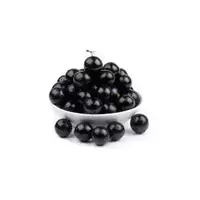Magonia padubolia berry

The magonia padubolia berry or Mahonia aquifolium is an evergreen shrub in the Barbaris family. The distribution range of magonia magonia berries is limited to North America, as well as territories running from British Columbia to California. Currently, researchers know about half a hundred varieties of magony padubolic.
In its appearance and biological structure, padubolic magonia is an evergreen shrub that does not exceed, as a rule, one meter in height. It is worth paying attention to the fact that magic belongs to those species of plants that differ in cross-pollination. This means that a single plant of magonia padubolia will not produce berries, since at least two shrubs must be planted nearby to obtain a harvest.
However, the vast majority of professionals agree that it is easier to grow padubolic magonia as an ornamental, not a fruit plant. It is noteworthy that padubolic magonia grows rapidly and, thanks to root offspring, quickly forms shrub thickets. Young magonia trees of padubolia differ in the color of their bark.
Magonia padubolic berries have an oblong and elliptical shape, differ in their black hiss. The plant blooms between April and May. Magonia padubolia berries can begin to be harvested in the month of August. It is worth noting that the magonia padubolic plant has long been used as a medicine in folk medicine.
The bark of magonia padubolia is used in homeopathy to treat some types of skin diseases. In pharmacological production, biologically active compounds obtained from magonia padubolia bark are used in the process of preparing drugs for psoriasis treatment. In Northern Europe, the magonia padubolia plant is used as an ornamental shrub.
Residents of this area do not even suspect what kind of storehouse of vitamins is used to decorate hedges. However, we should pay tribute to the plant really looks very aesthetically pleasing, and during the flowering of magony padubolic, the illusion of a carpet is created from bright inflorescences that stand out on the dark green foliage of the plant. Often, the magonia padubolia plant is used in floristics in the manufacture of flower arrangements and ornamental wreaths.
Magonia padubolia berries are used in cooking, and are also eaten fresh. Sweet and sour magonia padubolic berries have found widespread use in confectionery. Besides, magonia padubolia berries are used as a natural food colouring agent in the process of fruit-and-berry wines manufacture.
magony padubolic berries 29.6 kCal
The energy value of magonium berry is padubolic (Ratio of proteins, fats, carbohydrates - ju):
Proteins: 0 g (~ 0 kCal)
Fats: 0 g (~ 0 kCal)
Carbohydrates: 7.9 g (~ 32 kCal)
Energy ratio (bj | y): 0% | 0% | 107%
 Español
Español Français
Français Português
Português Русский
Русский 简体中文
简体中文 繁體中文
繁體中文 日本語
日本語 한국어
한국어 العربية
العربية Türkçe
Türkçe Қазақ
Қазақ Deutsch
Deutsch Italiano
Italiano Українська
Українська
